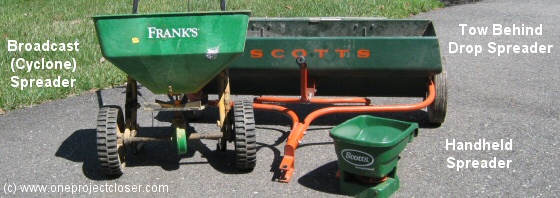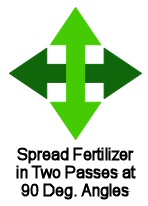
This article originally ran in 2009, but it’s a great one for spring time every year. Ethan mentioned it in yesterday’s post and since I’m a little short on time this week, I thought I’d re-run it with just a few minor modifications.
With Spring finally upon us, we’re turning our focus outdoors, and particularly to our lawns. Last week, I wrote about spreading crabgrass preventer early in the Spring before the days are regularly in the 50s. In a few weeks, we’ll be fertilizing our lawn again. So, now is a great time to review types of spreaders and the best way to spread chemicals like weed and feed on your lawn.
Which Type of Spreader for Fertilizer? | A Buying Guide
Properly spreading lawn chemicals starts with picking the right spreader. There are 4 common spreaders most homeowners employ to get this job done. In no particular order, they are:

Drop Spreaders for Medium-size Lawns
Drop spreaders do exactly what their name implies: they drop fertilizer or other chemicals on your lawn as you push them along. Unlike broadcast spreaders that throw the chemicals out in a wide radius, drop spreaders only lay chemicals right where you push them. Drop spreaders are great for small lawns (townhomes, small single family homes) or in tight spaces where you want to fertilize only in a small area–for instance, in a small patch of lawn between two gardens.
Since a drop spreader only spreads fertilizer directly beneath the drop point, you must be careful to cover the whole lawn to avoid striping or splotchyness.
Broadcast (Cyclone / Throw-style) Spreaders for Larger Areas
Broadcast, or cyclone-style spreaders are great for covering a larger area quicky. Typical push-style broadcast spreaders will throw chemicals between 2 and 3 feet in front of, and to the right and the left of the spreader (for a 5-6 ft. diameter). The advantages are obvious: you can make fewer passes on the lawn to spread the same amount of chemicals, and you’re far less likely to get striping or uneven application that is typical of drop spreaders. The disadvantage: it’s much harder to control where the chemicals land, so avoiding gardens, walkways, and other obstacles is more difficult.
Hand-held Spreaders for Easy Storage
Hand-held spreaders are great for small properties where you’ll only be spreading a small amount of chemicals. They offer a less-expensive alternative to a ground-based spreader and can be stored more easily. But, they can put quite a bit of wear and tear on your arm. Just like ground-based broacast spreaders, hand-held spreaders are good at getting complete coverage since they throw chemicals in a wide radius.
Tow-behind Spreaders (Tractor Tow Attachments) for Very Large Areas
If you’ve got a large property and a riding lawn-mower, there’s just no substitute for the pull-behind spreader. These spreaders are sold in both drop and cyclone styles (the drop style is shown in the picture above) and have the same basic advantages and disadvantages of push models.
Spreading Fertiziler and Other Chemicals
 Spreading chemicals like weed control evenly is the key to getting the most from any fertilizer you apply. Even chemical application ensures a lawn that looks evenly maintained and managed – a true pride of ownership. Read manufacturers guidelines about when to water your lawn and rainfall considerations to avoid runoff.
Spreading chemicals like weed control evenly is the key to getting the most from any fertilizer you apply. Even chemical application ensures a lawn that looks evenly maintained and managed – a true pride of ownership. Read manufacturers guidelines about when to water your lawn and rainfall considerations to avoid runoff.
For drop-style spreaders, you should always apply half of the chemicals going in one direction on the lawn, then make a second pass perpendicular to the first. In order to ensure proper application levels, this means cutting the application rate in half. For instance, if the chemical you’re spreading suggests applying it at a level 4 setting, you should make 2 passes, perpendicular to one another, at the 2 setting.
For broadcast-style spreaders, you should ensure that each “lap” overlaps the prior lap by a few inches. While not necessary, we recommend making two passes at right angles just as with drop spreaders, applying at half of the recommended rate each time.
For hand-held spreaders, we highly recommend the two-pass / half-rate method, since we think it is much harder to track application while you’re carrying the spreader (instead of pushing or towing it).







You can always use a tow behind broadcast spreader as well! I’ve got a large JD version that I tow behind my mower. My wife just thinks I like toys for my tractor!
Where do you find parts for a cyclone fertilizer spreader model 100-83 ?
Where can I purchase a broadcast spreader made by Cyclone?
Do they still make them? I tried googling and had no luck.
Thanks,
Pinky
I just bought some Panama Bermuda grass seed. It is extreamely small and i only have a broadcast spreader for fertilizers and lime. Unsure if i can get the opening small enough not to waste the seed. Do you have any recommendations or other types of spreaders better for this application. Thanks!
I am thinking about getting a spreader so that I can get my fertilizer spread out evenly across my lawn. I didn’t realize there are so many different options to choose from and you make a great point that hand-held spreaders are the best choice for small areas and they are easy to store! Also, the fact that these spreaders throw the chemicals of the fertilizer in a wide area will save me time.